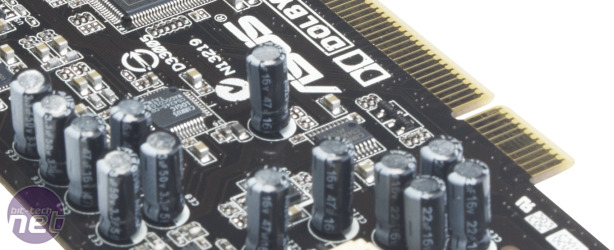Asus Xonar DG Gaming Performance and Conclusion
We were perfectly happy with the quality of the card’s output on all kinds of audio tracks, from dance music and death metal to normal speech. However, don’t bother with the environmental mixer settings, as these made little or no difference to the sound quality.The DG’s relatively low maximum sample rate of 96KHz/24-bit also made little actual difference to sound quality. MP3s, CDs, film and game soundtracks all use standard sample rates of 44.1KHz or 48KHz. High sample rates are great if you’re into audio production, but you wouldn’t buy a £23 sound card if you wanted to produce music digitally. Blu-ray audio has a native sample rate of up to 192KHz, but only sound devices that support Protected Audio Path (PAP) can take advantage of it, and the DG isn’t such a device.
When it came to games, this little sound card did a great job of producing rich, realistic and directional environmental audio. It’s an excellent gaming card, with solid bass that gives explosions the kind of reverberations we like to hear. Gamers will also appreciate the advantages provided by Asus’ Xonar drivers.
The most noteworthy of these advantages is its compatibility with ported or cross-platform games which sometimes don't work perfectly with certain codecs from companies such as Realtek. For example, the first patch for Mass Effect caused sound compatibility issues and there have been numerous examples since. The Xonar drivers shouldn't suffer from such issues.
Conclusion
The Xonar DG isn’t the best sound card you can buy in this price range. Asus’ own PCI Xonar DS costs roughly £8 more and has 7.1 analogue surround sound, a replaceable op-amp and a more powerful C-Media Oxygen HD CMI-8788 processor that provides a maximum sample rate of 192KHz (compared to the DG’s 96KHz). The Xonar DS lacks a dedicated S/PDIF port, though, instead sharing an optical S/PDIF with the 7.1 rear analogue output.The difference in audio quality between the Xonar DS and the Xonar DG is also negligible – movies, music and games all sound great through both cards. Both cards use Asus’ drivers, although the Xonar DS has more features. They also spare you the potential grief caused by audio compatibility issues with ported games.
If you just want the cheapest gaming sound card you can buy, the Xonar DG is the one, and paying £26 to avoid compatibility issues with on-board codecs for the next few years sounds like a good deal to us. For slightly more luxury, the Xonar DS is excellent, and if you want your sound card to outlast your next couple of PC builds then you should also consider Asus’ brilliant Xonar DX.
- Sound Quality
- x
- x
- x
- x
- x
- x
- x
- x
- -
- -
- 8/10
- Features
- x
- x
- x
- x
- x
- x
- x
- -
- -
- -
- 7/10
- Value
- x
- x
- x
- x
- x
- x
- x
- x
- x
- -
- 9/10
- Overall
- x
- x
- x
- x
- x
- x
- x
- x
- -
- -
- 8/10

Asus Xonar DG

MSI MPG Velox 100R Chassis Review
October 14 2021 | 15:04











Want to comment? Please log in.